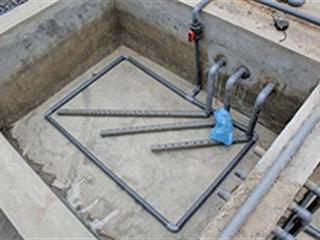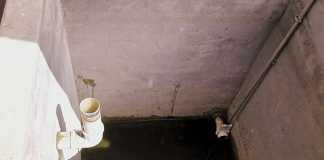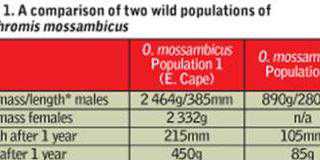
South African tilapia culture systems are invariably ‘under-filtered’, resulting in poor water quality, slow growth and marginal commercial viability. I’ve often seen well-built grow-out set-ups let down by inadequate filtration. These usually involve quite hi-tech systems, such as canister-type biofilters, bio-drums, skimmers and UV sterilisation, all designed by engineering ‘experts’, but invariably incapable of coping with the demands of the system at full load.
The consequence is filter failure just prior to harvest. Filtration should be over-engineered. This provides for a safety margin should things go wrong. That is, if stocking density is too high, if feeding has been excessive, or if a power failure results in the system not circulating for some time. Simply put, the filter volume should not be less than 30% of the grow-out tank volume. Thus, a system with 20 x 10 000l grow-out tanks requires 60 000l of filter capacity.
This may seem excessive when first stocking with fingerlings, but eight months later, with 8t of tilapia in the system, you’ll thank yourself for that spare capacity – especially when things go wrong. In a 30 x 10m tunnel system, a 60 000l filter will cover an area 7m x 7m x 1,3m deep – about 17% of the floor area. Excluding walkways and drain channels, that leaves around 80% for the grow-out tanks – a perfectly balanced set-up.
Tilapia cultured in a re-circulating system are typically fed 3% to 4% of their body mass dry feed per day. On fingerling stocking, the waste-load on the filtration is negligible, allowing time for the beneficial bacteria, which consume the ammonia, to colonise the filter medium. Later, the much larger fish will produce significant quantities of both solid and dissolved waste matter in the form of faeces and liquid nitrogenous wastes.
For example: 8t of fish, fed 4% body mass a day dry pellets (320kg feed), will produce nearly twice this mass in solid wet waste matter (500kg to 600kg a day) quite apart from that dissolved in the water, which can’t be seen. That’s a lot of waste for the filter to remove.
Gentle flow
Clearly a small settling tank coupled to an even smaller canister-type or rotating bio-drum biofilter, simply can’t be expected to cope with this load. The water needs to flow gently from the grow-out tanks by gravity (pumping breaks up the solid waste, blocking the biofilter) into the sediment tank, where it must have time to deposit its load before passing to the secondary filtration stage.
A deep V-shaped sediment tank is best with a volume of between 7 000l and 10 000l for a 30m tunnel system. It can’t be too large, or too deep. Screens take out the floating particles before the finest elements are removed in the secondary (mechanical) stage, which typically contains broken brick, gravel or similar coarse material.
Only then does the now clear water (which is still laden with ammonia) pass into the biofilter. Flow rates through the biofilter should be slow. The bacteria need time to do their job – of changing the nitrogenous waste to nitrite. A ‘residence time’ in the biofilter of between 15 and 30 minutes is desirable, thus its volume requires that the pumping rate takes this time to fill it.
If the biofilter volume is around 48 000l (75% of the total filter volume), then a pumping rate of 90 000l an hour will suffice, and this is enough to change the volume of each grow-out tank in a 200 000l system about 10 times a day. In practice, about half this is adequate.
Filter medium
Filter-medium is always a problem. ‘Hair-curler’ type bio-balls are the best, but ridiculously expensive. Alternatives are 19mm gravel, plastic shavings, PVC pipe offcuts, giant bottlebrushes, shade netting and large ceramic beads. In fact, any inert material with a high surface-to-volume ratio will do.
Just remember that a filter of this size will need around 48m³ of the material. Anything less than this will run the risk of system overload at the most critical time – and that means dead fish. Submergent plants with fine leaves or emergent long-rooted aquatic ones can assist filtration. However, the surface area under plants needed to be effective is often beyond the capacity of tunnel filtration systems.
Nicholas James is an ichthyologist and hatchery owner. Contact him at [email protected]. Please state ‘Aquaculture’ in the subject line of your email.













